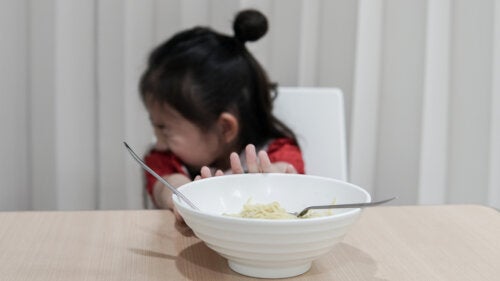The 2 Main Eating Disorders in Children

Although you may not believe it, children can also suffer from eating disorders. These problems condition the diet and nutrition of the youngest children and can have serious harmful effects. It’s important to take into account that if nutrient deficiencies are experienced during the first stages of life, growth can be put at risk. Keep reading to learn about the main eating disorders in children.
These are the main eating disorders that occur in children
Eating disorders have an important psychological component. That’s why it’s crucial to detect them early on and approach them from a multidisciplinary point of view. Otherwise, they could have lifelong consequences and affect the child’s sense of well-being. Learn about the main disorders below.
1. Anorexia in children
Anorexia is characterized by a strong dietary restriction, as stated in a study published in the journal Current Problems in Pediatric and Adolescent Health Care . It’s associated with a depressive pattern, and early treatment is essential to prevent progression. Warning signs are often poor appetite and food avoidance.
In these cases, there’s often a deficit in calorie and protein intake that stunts growth. Also, children become underweight, which can lead to malnutrition. At the same time, it’s possible that the child who develops this problem tends to be lonely and has social problems.

2. Bulimia, one of the most common eating disorders
Bulimia is often marked by the presence of dietary restrictions and subsequent binge eating that ends in purging behaviors. This is evidenced by research also published in the journal Current Problems in Pediatric and Adolescent Health Care . After uncontrolled food consumption, there’s a tendency to vomit or to use enemas to stimulate bowel movements.
In these cases, an alteration at the oral level is usually detected, especially in the enamel of the teeth. The child doesn’t always become underweight, but stomach acid often leaves signs that allow for the identification of purgative behaviors. Children with these disorders are usually more socially open, as opposed to those who develop anorexia.
How to deal with eating disorders in children?
If the presence of an eating disorder is detected, it’s crucial that you consult a specialist as soon as possible. It’s best to opt for a multidisciplinary treatment that includes a nutritionist, a psychologist, and a psychiatrist. Sometimes, the use of pharmacology is necessary to also treat episodes of anxiety and depression, which are frequent in these cases.
Be patient and understanding with the child
You must take into account that it’s essential that you develop patience and understanding with children suffering from these problems. Normally, the solution isn’t immediate and requires a process that can last for months. However, a good treatment will be able to prevent collateral damage during adulthood.
Consult a professional
Also, keep in mind that many eating disorders are the result of traumatic events. Abuse, the loss of a family member, or a situation of loneliness can be major triggers. The truth is that their prevalence in children has increased in recent years, although they’re conditions that are more typical of adolescence. In all cases, it’s essential that you consult a professional.

Avoid watching certain television programs
At the same time, we mustn’t forget the negative influence that the media have on the mental health of young people. The canons of beauty and the behaviors observed in television programs can trigger these kinds of disorders, especially when unhealthy references are generated.
Eating disorders in children, a growing health problem
As you’ve seen, eating disorders are complex problems, both in diagnosis and treatment. It’s essential to detect them in time in order to remedy them during the early stages. Otherwise, there may be lifelong sequelae that negatively affect diet.
In the case of children, we must be very attentive to behaviors that are considered abnormal. If they spend too much time locked in the bathroom, if they have a poor appetite, if they compare themselves to their siblings or classmates, or if they’re reluctant to relate to other peers, you can suspect the existence of a problem of this type.
If and when there’s suspicion, it’s best to consult a professional and approach the issue with some caution and patience. Otherwise, it could produce a negative response from the children and complicate the subsequent treatment.
All cited sources were thoroughly reviewed by our team to ensure their quality, reliability, currency, and validity. The bibliography of this article was considered reliable and of academic or scientific accuracy.
- Moskowitz, L., & Weiselberg, E. (2017). Anorexia Nervosa/Atypical Anorexia Nervosa. Current problems in pediatric and adolescent health care, 47(4), 70–84. https://doi.org/10.1016/j.cppeds.2017.02.003
- Castillo, M., & Weiselberg, E. (2017). Bulimia Nervosa/Purging Disorder. Current problems in pediatric and adolescent health care, 47(4), 85–94. https://doi.org/10.1016/j.cppeds.2017.02.004
